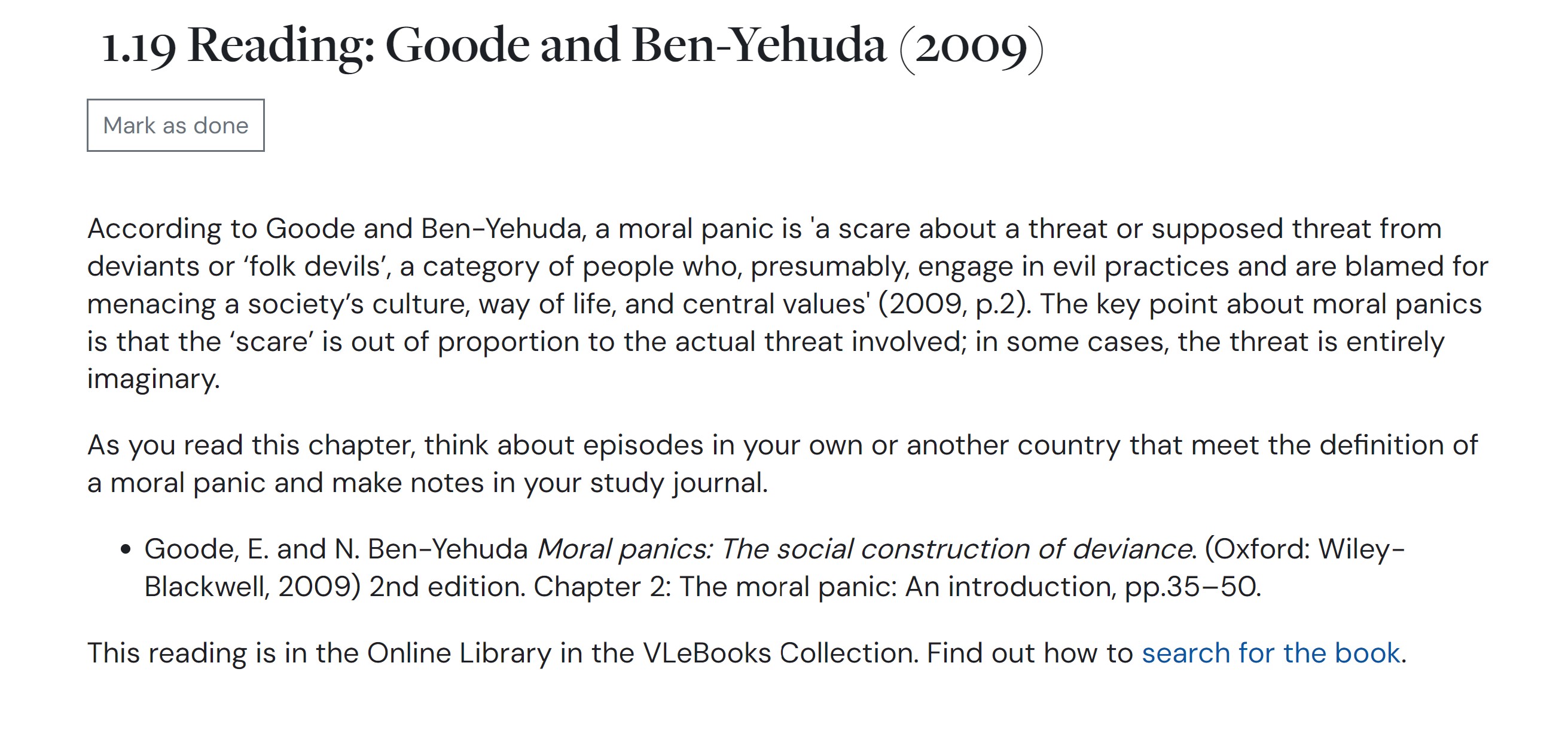How to complete your module content
| vef: | Your site |
| Áfangi: | Module development handbook |
| Bók: | How to complete your module content |
| Printed by: | Fa'aaoga mo e asiasi mai |
| Date: | fimmtudagur, 17. apríl 2025, 8:27 PM |
Lýsing
Now you've completed your scripts and slides, you'll move on to finalising your module content. This section has guidance on how to do this.
1. General tips
- Don't refer to students in the third person (for example, 'This week the students will...'). Always address them as 'you' or 'we' (for example, 'This week you will discuss...' or 'We will examine...').
- Always explain jargon or acronyms that students might not be familiar with.
- Try to avoid using language that is too figurative or that relies too much on idiom – students might struggle to understand your meaning if English is not their first language, even if you think it's a common enough phrase!
- Avoid extensive use of italics or bold for emphasis.
- Always include full citations for sources and quotes.
2. Titles
Remember to include titles for all lessons, weeks, readings, lectures and activities in your module. These should be more than just 'Lesson 1' or 'Reading' or the title of the book/article. Ideally, the titles should be descriptive and inform students.
Example
Reading: The four Ps of marketing
Discussion: Why do you think marketing is important?
Activity: Case study – marketing strategy failures
The following is an example of titles in a MSc Global environment and sustainability module, 'Biodiversity, Biosecurity and Conservation' for 'Week 7: Biodiversity conservation and economic development'.

3. Readings
The online library will provide further guidance about how to select your readings. For each reading, you will need to provide an introduction; this might include, for example, the reading's relevance to the topic, particular ideas that you want the students to focus on or think about while they read, or a summary of the author's importance in the field.
Remember that:
- Readings can come from a combination of chapters and articles.
- Reading times are estimated at five minutes per page.
- If YouTube videos are used in activities, please provide a text alternative. Each student must be able to perform the activity based on either the reading or the YouTube link.
- Due to licensing restrictions, we are unable to include Harvard Business Review articles.
Examples
The following are examples of readings with their introductions from an MSc Criminology module, 'Psychological and social causes of crime and offending'.


4. Introductions and summaries
For each week, you will need to write an introduction and a summary. These should contextualise the content and make it clear what the students will be learning / will have learned.
Example
The following are examples of a topic (i.e. week) introduction and summary from an MSc Criminology module, 'Psychological and social causes of crime and offending'.


5. Quizzes
A quiz can also be included at the end of the topic as a revision point for students. Each quiz consists of 10 standard short answer, MCQs, True-False, MRQs, FIBs and/or Select type questions – all need to include a marked answer and feedback. Feedback can include referring students back to relevant sections in the essential reading or course pages. These questions should relate to what students have just read (or watched).
Example
The following is an example of a multiple choice quiz question with feedback from an MSc Cyber Security module, 'Computer systems security'.

6. Long-answer questions
You could also include more detailed, long-answer questions. In order to make this worthwhile for students, supply a model answer or some guidance on answering the question so that students can compare their answer with that and judge how well they did. These model answers will be hidden from the students until they choose to read them. Students may need to do the reading again in order to understand the answer provided – please supply cross-references.
Example
The following is an example of a question and model answer from an MBA module, 'Economics for managers'.
What do you think were the main factors contributing to the behaviour of financial institutions in the run up to the global financial crisis in 2008?
How confident are you that you did well on this exercise? If you struggled, you may find it helpful to go back to the essential reading for this topic, Mankiw, Taylor and Ashwin (2019), Chapter 1: What is business economics?
Model answer
- Risky lending: Financial institutions, seeking high returns, engaged in risky lending practices, offering mortgages to borrowers with limited creditworthiness, which created a housing bubble that eventually burst.
- Complex financial products: Banks bundled mortgages into complicated financial products that were difficult to understand and assess their underlying risks.
- Excessive risk-taking: Financial institutions, driven by short-term profits and incentivised by a compensation structure that rewarded risk-taking, took on too much risk and made speculative investments.
- Regulatory failures: Regulators didn’t properly oversee the financial industry, allowing risky practices to go unchecked.
- Lack of transparency: Investors couldn't see the true risks associated with complex financial products, leading to false confidence.
- Global financial interconnectedness: Problems in one part of the financial system spread quickly and affected banks worldwide, causing a widespread crisis.
It is important to note that these factors are interrelated and contributed to a complex web of systemic vulnerabilities. The combined effect of these factors led to a breakdown in the financial system, triggering the global financial crisis of 2008. The root of the crisis could be said to be financial institutions’ risky lending practices, encouraged by a sense of being protected due to their economic importance – they were deemed ‘too big to fail’.
7. Links
Where possible, we suggest directing students to complete their own searches, rather than giving them direct links. You can give them prompt words, or the name of the website in order to give students clear instructions to find the material they need. This also encourages them to become independent learners – after all, this is what they would need to do outside of the module.
Please supply all links to your editor in full and check that they work.
8. Images
If you want to use images in any of your content, we have to make sure that their licenses allows this. Contrary to popular belief, images from a Google Image search still retain copyright and so you cannot reuse them unless you have permission or the owner has specifically waived copyright.
The following image banks are copyright-free, so you can use the images how you want:
- Unsplash
- Pexels
- Pixabay
- Noun Project (for icons; please note these require attribution where the previous ones do not)
- Wikimedia Commons (often require attribution)
We also have access to paid-for stock images and stock footage from Storyblocks, which you can browse for suggestions to discuss with your video editor if you can't find something you want among the free image banks.
Before using an image, consider what it is adding to your content or presentation. Will it enhance a students' understanding or will it add clutter and distract from the main points you are making?